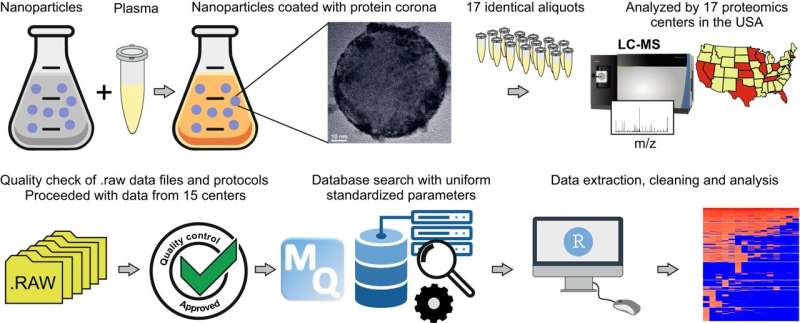This article has been reviewed according to Science X's editorial process and policies. Editors have highlighted the following attributes while ensuring the content's credibility:
fact-checked
peer-reviewed publication
trusted source
proofread
Researchers set new standards for nanoparticles, helping patients with MS, ALS, Parkinson's disease

Is it possible for nanoparticles to go through the digestive system and deliver medicine directly to the brain tissue? Researchers from Michigan State University say yes, and their latest findings are expected to benefit patients with neurodegenerative disorders like multiple sclerosis, or MS; amyotrophic lateral sclerosis, or ALS; and Parkinson's disease, or PD.
"Our work is focused on identifying the biological identity of nanoparticles, including the type of proteins that come to their surfaces," said Morteza Mahmoudi, an associate professor in the Department of Radiology in the MSU colleges of Osteopathic Medicine and Human Medicine and Precision Health. "This is important because the type of proteins that come to the surface provide a unique pattern that can give the green light to pass the blood brain barrier and work directly in the brain tissues."
Consistency in lab analysis of nanomaterials
Mahmoudi and his research team have published two papers on the biological identity of nanoparticles. The first, titled "Measurements of heterogeneity in proteomics analysis of the nanoparticle protein corona across core facilities," was published in Nature Communications in 2022.
The second, more recent article, "A uniform data processing pipeline enables harmonized nanoparticle protein corona analysis across proteomics core facilities," was published in Nature Communications in January 2024. It establishes the need for standardized procedures in protein corona analysis, which is vital for advancing clinical applications of nanoscale biotechnologies.
"We prepared identical nanoparticles with the protein corona and sent them to 17 different evaluation centers," Mahmoudi said. "We found significant data variability with only 1.8% of proteins consistently identified by all, so we developed a method of analysis to help labs more accurately reproduce data from the biological identity of nanoparticles. This will help the scientific community be more harmonized."
Nanoparticles treat neurodegenerative diseases
Related work, "Protein corona composition of gold nanocatalysts," was published in ACS Pharmacology & Translational Science. This analysis, done for Clene Nanomedicine, Inc., or Clene, a clinical-stage biopharmaceutical company, explains how the protein corona of their gold nanocrystals in CNM-Au8 help treat neurodegenerative diseases.
"Because we have more than 15 years of evolving experience with robust analysis of protein corona, we were able to work with Clene to shed light on the biological identity of their nanoparticles," Mahmoudi said.
CNM-Au8 is comprised of a suspension of clean-surfaced, faceted gold nanocrystals that patients can take orally. The nanocrystals pass through the gastrointestinal tract and enter the body's circulatory system where they interact with, and become coated by, blood proteins and other biomolecules. This forms the protein/biomolecular corona.
"This composition enhances the nanocrystals' ability to traverse the blood-brain barrier," Mahmoudi explained. "Our research shows that these gold nanocrystals, manufactured using a novel method to form specific structures and without surfactants, can form a distinct protein corona that facilitates access to brain tissue."
More information: Hassan Gharibi et al, A uniform data processing pipeline enables harmonized nanoparticle protein corona analysis across proteomics core facilities, Nature Communications (2024). DOI: 10.1038/s41467-023-44678-x
Ali Akbar Ashkarran et al, Protein Corona Composition of Gold Nanocatalysts, ACS Pharmacology & Translational Science (2024). DOI: 10.1021/acsptsci.4c00028
Journal information: Nature Communications
Provided by Michigan State University





















